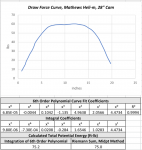Greenmachine_1
Lil-Rokslider
- Joined
- Jul 13, 2019
- Messages
- 166
I feel like we have the same questions...What speeds are you getting with the 406 and 438 gr arrows?
Sent from my Pixel 2 XL using Tapatalk
I feel like we have the same questions...What speeds are you getting with the 406 and 438 gr arrows?
Very curious. Those numbers run counter to all the KE data I've gathered, although I've never tested your particular bow model. It would be interesting to try additional heavier arrows to see if the KE downtrend continues. All my testing has shown a gradual increase in KE with increasing arrow weight similar to the attached graph.
View attachment 210375
Okay. Like @Mighty Mouse My only theory is that a severely underspined arrow might take too much energy and create a drop. The other idea is that there is another issue with the bow. Whatever works for you though.
Sent from my Pixel 2 XL using Tapatalk
Yes I am. My working theory is that a bow's KE is constant (all things being equal) because of the conservation of energy. So when you draw your bow you put all of the energy into the bow. When you release the arrow, the bow transfer the energy to the arrow minus the losses due to friction, noise, vibration, etc. Which are not transferred to the arrow.Are you referring to my setup?
Yes I am. My working theory is that a bow's KE is constant (all things being equal) because of the conservation of energy. So when you draw your bow you put all of the energy into the bow. When you release the arrow, the bow transfer the energy to the arrow minus the losses due to friction, noise, vibration, etc. Which are not transferred to the arrow.
So if the conservation of energy is to be believed, your KE should be very consistent and generally slightly higher, due to the fact that heavier arrows slowdown a bow and speed is the enemy of kinetic friction.
It's weird to me to see the KE lower. I could be wrong and it's nothing, just incredibly interesting to me when reality doesn't agree with theory.
Sent from my Pixel 2 XL using Tapatalk
I agree with you except for one minor correction: a bow's potential energy remains constant, not the amount of kinetic energy the bow imparts to the arrow.Yes I am. My working theory is that a bow's KE is constant (all things being equal) because of the conservation of energy. So when you draw your bow you put all of the energy into the bow. When you release the arrow, the bow transfer the energy to the arrow minus the losses due to friction, noise, vibration, etc. Which are not transferred to the arrow.
So if the conservation of energy is to be believed, your KE should be very consistent and generally slightly higher, due to the fact that heavier arrows slowdown a bow and speed is the enemy of kinetic friction.
It's weird to me to see the KE lower. I could be wrong and it's nothing, just incredibly interesting to me when reality doesn't agree with theory.

I don't doubt there are bow/arrow combinations out there that show they are more efficient with lighter or heavier arrows. That doesn't justify the claim that it extends beyond that bow because there is just too much data out there to suggest otherwise. Said another way, most bows will show more KE with heavier arrow weights.
I would love to see your raw data for when this happened, because I'm not sure KE could actually fall off. I suspect if someone were to start losing energy on their heavier arrows that it was related to another factor. The other option is that the arrow was so heavy it was losing enough speed by the time it passed the Chrono that it appeared to be losing energy.
What I would expect to see, is more of a velocity versus momentum balance where arrow flight is good, energy is near the theoretical maximum, and effective range is still acceptable for the shooter.
Interesting discussion though.
Sent from my Pixel 2 XL using Tapatalk
Depending on how you draw your box and label the events, you are correct and I agree with you. Personally, I would define your PE factor as follows:I agree with you except for one minor correction: a bow's potential energy remains constant, not the amount of kinetic energy the bow imparts to the arrow.
A bow's PE is a function of draw weight, draw length, brace height, cam profile, and let-off percentage, and PE remains fixed as long as those parameters aren't changed. With modern compound bows, ≈90% of the PE developed during the draw cycle gets transferred to the arrow. The other 10% is "lost" to friction in moving components, acceleration of the string and accessories, continued movement of the string after the arrow decouples, and vibration of the limbs/riser. These losses are perceived as noise and "hand shock." The amount of PE developed in the bow is fixed, but energy losses decrease with increasing arrow weight; thus, a heavier arrow receives more energy from the bow than a lighter arrow (and the bow tends to be quieter with less post-shot vibration). The KE increase is relatively small though, and for practical purposes, KE can be assumed to remain constant.
As an aside, a bow's PE can be calculated by plotting a draw force curve and calculating the area under the curve (via integration or Riemann sum approximation). Attached is a draw force curve with calculated PE for the Mathews Heli-m I used to generate the KE data I previously posted. In my testing with that particular bow, PE to KE transfer efficiency ranged from 87% to 92% with higher efficiency at heavier arrow weights.
View attachment 210399
The theory still stands that a heavier arrow should have more KE than a lighter arrow up to a theoretical limit where other factors play a role.
It is true for most bows, although there probably are bows that achieve peak KE at an unusually low arrow weight (your bow may be one of these exceptions). If you don't trust my previously posted data that demonstrates KE increasing with arrow weight, here's another dataset showing the same trend:Nice theory, too bad it ain’t true.

What were differences of speed and arrow weights as you went from a lighter arrow to a heavier one?
It's been years since I did the tests I did, but from 375 grs to 635 grs every bow I tested showed more KE the heavier the arrow got. It makes sense from a physics perspective as heavier arrows are quieter, meaning they are absorbing more of the bow's energy. The last time I did it I calculated the difference from low to high and it was 4% give or take, so very little
Momentum and KE in physics describe 2 different events.I'll see if I can find my notes. It was several years ago, meaning likely a few notebooks ago. I could repeat it.
Like I said momentum will keep increasing, however with ke squaring velocity it starts to fall off at a point.
If you said momentum, then I would agree.
We're on the same page. My amendment to your earlier statement was intended to point out that, using your nomenclature, PEf stays constant while KEa and Ef change: Ef decreases slightly and KEa increases a commensurate amount as arrow weight increases. PEi also stays constant but since it appears on both sides of the equation, it cancels out anyway. I'm not quite sure what losses you're accounting for with Ei, but there's no reason that parameter would change with arrow weight.Depending on how you draw your box and label the events, you are correct and I agree with you. Personally, I would define your PE factor as follows:
So you have PEi which is the initial energy that the bow has all of the time. The KEi is the energy that is added to the bow to draw it. So total energy would be PEi+KEi+Ei=PEf(Ei being the amount of energy lost while holding at full draw assuming a compound bow). When the string is released, PEf=KEa+PEi+Ef (KEa being the kinetic energy of the arrow, Ef being the losses of the energy transfer).
The things that are going to play into an arrows performance are KEa and Ef are as you described. The theory still stands that a heavier arrow should have more KE than a lighter arrow up to a theoretical limit where other factors play a role. I haven't shot to the limit and have no data to back it up.
I agree that we're deep in the weeds on a mostly academic topic that has little practical relevance for hunting/arrow selection. But understanding the basic physics of a bow does help clear up popular misconceptions such as "I can't increase arrow weight because I'll lose KE" that can artificially and unnecessarily limit folks in their arrow choices.None of this has anything to do with actual hunting or the OP's question.
It is true for most bows, although there probably are bows that achieve peak KE at an unusually low arrow weight (your bow may be one of these exceptions). If you don't trust my previously posted data that demonstrates KE increasing with arrow weight, here's another dataset showing the same trend:
View attachment 210443
And another, although the trend is less pronounced with this data since the arrow weights only vary by 30 gr: https://www.bowhuntingmag.com/editorial/3-rules-of-thumb-to-follow-for-consistent-arrow-speed/310532
I agree. I was using that as demonstration to what is typical.We're on the same page. My amendment to your earlier statement was intended to point out that, using your nomenclature, PEf stays constant while KEa and Ef change: Ef decreases slightly and KEa increases a commensurate amount as arrow weight increases. PEi also stays constant but since it appears on both sides of the equation, it cancels out anyway. I'm not quite sure what losses you're accounting for with Ei, but there's no reason that parameter would change with arrow weight.
I agree that we're deep in the weeds on a mostly academic topic that has little practical relevance for hunting/arrow selection. But understanding the basic physics of a bow does help clear up popular misconceptions such as "I can't increase arrow weight because I'll lose KE" that can artificially and unnecessarily limit folks in their arrow choices.